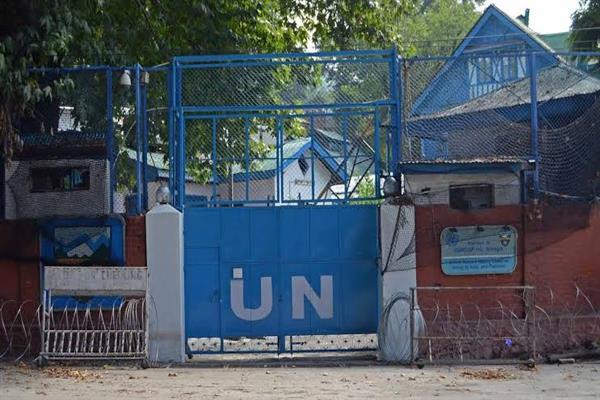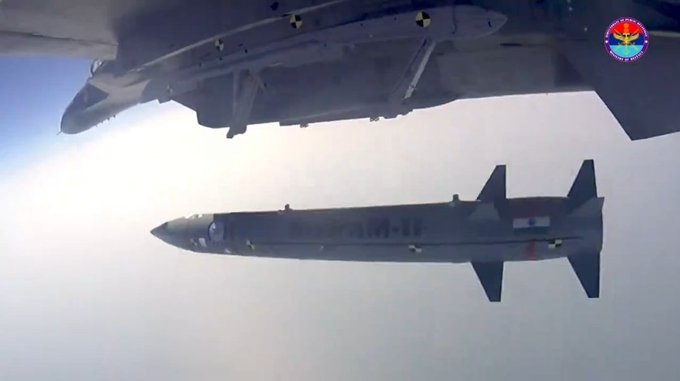Monthly Archives: April 2025
SOURCE: AFI


India and Pakistan have long maintained a fragile agreement that restricts the movement of military aircraft, including fighter jets, near their shared borders. Under the terms of this understanding, both sides are prohibited from operating military jets within a 10-kilometer buffer zone along the border to reduce the risk of accidental escalation and to maintain a basic level of trust.
However, in recent years, there have been multiple instances where this agreement has been breached — particularly by the Pakistan Air Force (PAF). Fighter jets and other military aircraft have frequently been seen coming dangerously close to, and at times crossing, the 10-kilometer mark. Each of these breaches carries a significant risk of sparking a larger military confrontation, whether intentional or accidental.
Continue readingSOURCE: AFI


On April 27, 2025, reports surfaced on social media platforms, including posts on X, alleging that the Pakistan Army has deployed Chinese-origin SH-15 truck-mounted 155mm/52-caliber artillery systems in populated areas of Lahore, raising concerns about potential military strategies and their implications for regional security. These advanced howitzers, capable of striking targets up to 53 kilometers away with rocket-assisted projectiles (RAP), could theoretically reach the Indian city of Amritsar, located approximately 50 kilometers from Lahore.
Speculation suggests that Pakistan may be adopting tactics observed in the Ukraine conflict, concealing heavy weaponry within civilian areas to complicate targeting and response. This development has sparked debate about Pakistan’s military intentions, the role of Chinese defense technology, and the risks of escalating tensions along the India-Pakistan border.
Continue readingSOURCE: AFI


A video circulating widely on social media, particularly noted on X on April 27, 2025, features an alleged Pakistani Air Force (PAF) pilot claiming that the PAF shot down 21 Indian Air Force (IAF) fighter jets during a single operation. While the video is undated, its context and the pilot’s uniform suggest it may have been recorded shortly after Operation Swift Retort, the PAF’s retaliatory airstrikes on February 27, 2019, following India’s Balakot airstrike.
The exaggerated claim, unsupported by historical evidence, has reignited debates about the PAF’s reliance on propaganda, its pursuit of personal glory, and its limited role in supporting Pakistani Army ground operations. This article examines the video’s implications, the reality of Operation Swift Retort, and the broader strategic motivations behind such claims.
Continue readingSOURCE: AFI


In the wake of heightened tensions following the April 22, 2025, Pahalgam terrorist attack, which killed 26 tourists and was linked to Pakistan-backed militants, India has intensified its efforts to curb the influence of Pakistani YouTube channels within its borders. Social media posts on X, notably by @kushal_mehra
on April 26 and 28, 2025, indicate that several Pakistani YouTube channels, including those of Syed Muzammil, Aarzoo Kazmi, and Wassey Iffy, are facing bans in India, with users encountering screenshots signaling restricted access.
While many channels remain accessible, the Indian government’s actions suggest a broader campaign to block content deemed anti-India or propagandistic, driven by concerns over disinformation and national security. This escalation, part of India’s multifaceted response to Pakistan’s alleged terrorism sponsorship, marks a new front in the information warfare between the two nations, with significant implications for digital diplomacy and regional dynamics.
Continue readingSOURCE: RAUNAK KUNDE / NEWS BEAT / IDRW.ORG


The Dynamics and Aeroelasticity Group within the Airframe Directorate of the Aeronautical Development Agency (ADA) plays a pivotal role in ensuring the structural integrity and performance of India’s indigenous combat aircraft. The group is tasked with conducting structural dynamic, flutter, and aeroelastic response analyses, as well as coordinating testing activities for the Light Combat Aircraft (LCA) Airforce Mk-1, LCA Airforce Mk-2, and the Advanced Medium Combat Aircraft (AMCA) programmes.
Modern aircraft design demands rigorous analysis to ensure structures can withstand dynamic loads and remain free from vibration and flutter across the entire flight envelope. For the LCA Mk-2, this process is particularly critical due to the inclusion of an additional control surface—a canard—which requires detailed aeroelastic characterization to validate its performance and safety.
Continue readingSOURCE: RAUNAK KUNDE / NEWS BEAT / IDRW.ORG


Officials from the Gas Turbine Research Establishment (GTRE) have told idrw.org that the organization is confident in its ability to develop and deliver the Kaveri 2.0 engine within five to seven years, provided that the Indian government approves funding and the Indian Air Force (IAF) backs the program.
Speaking to idrw.org, an official closely associated with the current Kaveri Derivative Engine (KDE) project revealed that GTRE aims to achieve final certification for the KDE by the end of 2026. Once certified, the engine will be flight-tested on an older LCA-Tejas Mk1 platform as a demonstrator to showcase the maturity of the technology and its potential evolution into Kaveri 2.0.
Continue readingSOURCE: RAUNAK KUNDE / NEWS BEAT / IDRW.ORG


In a significant leap forward for India’s defense capabilities, DRDO Chairman Dr. Samir V. Kamat has confirmed that the Defence Research and Development Organisation (DRDO) is developing Laser Directed Energy Weapons (LDEWs) that can be mounted on airborne platforms. This ambitious initiative will bolster India’s ability to neutralize aerial threats with pinpoint precision using energy-based technologies.
This confirmation aligns with earlier revelations by idrw.org, which reported that DRDO is working on megawatt (MW)-class LDEWs intended for integration onto larger aircraft platforms such as the Airbus A320, with the initial focus on developing kilowatt (kW)-class systems for rotary and smaller fixed-wing platforms.
Continue readingSOURCE: AFI


In the complex and volatile India-Pakistan strategic landscape, Pakistan’s development of tactical nuclear weapons (TNWs) has raised concerns about their potential use in a future conflict. Specifically, speculation has emerged that Pakistan could deploy TNWs to target high-value Indian naval assets, such as aircraft carriers, given the Indian Navy’s robust defenses against conventional threats like subsonic cruise missiles. This article examines the plausibility, implications, and strategic dynamics of such a scenario, focusing on the Indian Navy’s aircraft carriers and their defenses, notably the Medium-Range Surface-to-Air Missile (MR-SAM) system.
India’s aircraft carriers, including the INS Vikramaditya and the indigenously built INS Vikrant, are linchpins of the Indian Navy’s power projection in the Indian Ocean Region (IOR). These carriers, costing billions of dollars, are critical for maintaining maritime dominance, securing sea lines of communication, and projecting air power far from Indian shores. In a potential conflict with Pakistan, they would play a pivotal role in enforcing blockades, conducting strikes, and countering Pakistan’s naval and air assets.
Continue readingSOURCE: AFI


In the volatile South Asian geopolitical landscape, India and Pakistan maintain robust air defense systems to counter aerial threats, reflecting their ongoing rivalry and mutual deterrence strategies. A comparative analysis of their air defense systems, as detailed in a recent infographic shared on X, reveals stark contrasts in range, radar technology, and target engagement capabilities.
With India’s layered, multi-tiered defenses contrasting against Pakistan’s more limited but evolving systems.
Continue readingSOURCE: AFI


On April 28, 2025, a Lockheed C-130 Hercules belonging to the Turkish Air Force was tracked flying over the Arabian Sea, as reported by the flight tracking service ADS-B Exchange. The aircraft, bearing the registration number 68-01606 and operating under the call sign TUAF509, was detected at 14:20:11Z (UTC) with a squawk code of 4701.
The flight’s unusual route, which appeared to be heading toward Karachi, Pakistan, has sparked widespread curiosity about its purpose and Turkey’s military activities in the region. Open-source intelligence (OSINT) analysis and flight tracking data have fueled speculation that the aircraft may be involved in an urgent transfer of ammunition for Pakistan’s unmanned aerial vehicle (UAV) fleet.
Continue readingSOURCE: AFI


The United Nations Military Observer Group in India and Pakistan (UNMOGIP), established in 1949 to monitor the ceasefire line in Jammu and Kashmir, has long outlived its relevance. With its main office in Srinagar, the UNMOGIP has been a vestige of a bygone era, rooted in a context that no longer aligns with the region’s geopolitical realities.
As India asserts its sovereignty over Jammu and Kashmir, particularly following the revocation of Article 370 in 2019, it is time for the government to decisively close the UNMOGIP office in Srinagar. This move would reaffirm India’s stance that Jammu and Kashmir is an integral part of the nation and signal an end to outdated international oversight.
Continue readingSOURCE: IDRW.ORG


In a passionate address, Air Vice Marshal Suresh Singh (Retd) has called for India to abandon hopes of co-designing or co-developing the Advanced Medium Combat Aircraft (AMCA) engine with international partners, asserting that no foreign entity will share critical jet engine technology. Speaking with conviction, he emphasized that India must stand on its own feet and develop the 120kN engine indigenously, leveraging its own resources, talent, and determination.
Singh dismissed the notion of foreign technology transfer, stating, “Nobody in the world is going to co-design, co-develop, or give technology to you. Take it from me—100% technology, no one will give.” He argued that global aerospace giants, having invested vast sums of money, time, and resources, are unwilling to share proprietary technologies that could create future competitors. “Why should they lose revenue by giving you the edge?” he questioned, urging India to chart an independent path.
Continue readingSOURCE: IDRW.ORG
)

Hindustan Aeronautics Limited (HAL), India’s premier aerospace and defense manufacturer, is taking a significant step toward enhancing its footprint in civil aviation by pursuing Approved Training Organization (ATO) status for pilot training on the Do-228, also known as the Hindustan-228 aircraft. According to a report by Halldale Group, this move aims to establish HAL as a key player in regional pilot training, aligning with India’s ambitious Ude Desh ka Aam Nagrik (UDAN) scheme to boost regional connectivity.
By offering certified training for the 19-seater commuter aircraft, HAL seeks to support operators, reduce training costs, and strengthen India’s aviation ecosystem, all while leveraging its decades of experience in manufacturing and maintaining the Dornier-based platform.
Continue readingSOURCE: AFI


The evolving maritime security landscape in the Indian Ocean Region (IOR) demands that the Indian Navy maintain a decisive edge over potential adversaries, including the Pakistan Navy. With the Pakistan Navy modernizing its fleet and acquiring advanced submarines and surface combatants, India must leverage its technological and strategic advantages to ensure maritime dominance. One potent option is arming the Indian Navy’s Boeing P-8I Neptune maritime patrol aircraft with the Rudram-II anti-ship missile variant, a move that could significantly enhance its offensive capabilities and deterrence posture.
The Pakistan Navy, though smaller than its Indian counterpart, has been steadily enhancing its capabilities. With Chinese assistance, it has inducted advanced platforms like the Type 054A/P frigates and Yuan-class submarines equipped with anti-ship cruise missiles (ASCMs) and torpedoes. These assets, combined with Pakistan’s focus on sea denial strategies, pose a credible threat to Indian naval operations, particularly in the Arabian Sea. The Pakistan Navy’s ability to deploy submarines and surface combatants in choke points like the Gulf of Oman or near the Makran coast underscores the need for India to maintain long-range, precision strike capabilities.
Continue readingSOURCE: AFI

In a provocative escalation of tensions between India and Pakistan, Federal Minister for Railways Muhammad Hanif Abbasi has issued a stark warning, claiming that Pakistan possesses 130 nuclear warheads strategically dispersed across the country, ready to be deployed in the event of an Indian attack. Speaking at a press conference at his residence in Rawalpindi on April 26, 2025, Abbasi further asserted that Pakistan’s missile arsenal, including the Ghori, Shaheen, and Ghaznavi missiles, is exclusively targeted at India, signaling a readiness for “full-scale war” if provoked.
This inflammatory rhetoric comes in the wake of India’s suspension of the Indus Waters Treaty following the deadly Pahalgam terror attack on April 22, which killed 26 people, intensifying the already volatile India-Pakistan relationship.
Continue reading